#cook:おから
Explore tagged Tumblr posts
Photo

✿ ツナチーズおからパン ✍️ 巻かずにピザ生地へ
#cook:ツナチーズおからパン#cook:おからパン#cook:おから#cook:おからパウダー#cook:パン#cook:ツナ缶#cook:ピザ#cook:主食#cook:手作りパン#cook:2020〜#ツナチーズおからパン#cook:おから×豆腐#cook:豆腐#cook:絹ごし豆腐#cook#cook:主食:おから#cook:healthy#cook:healthy:主食
0 notes
Photo

なう(2023/03/19 20:31:32) 今夜は鶏の唐揚げ🐔✨旦那の大好物🐓💕 蓮根もそろそろヤバかったのでスライスして 揚げた🙌おからの煎り煮は向かいのお婆ちゃん作👵 #鶏と蓮根の唐揚げ #もやしナムル #おからの煎り #家飲み #おうち居酒屋 #おうちごはん #お家ごはん #おうちごはん部 #おうちごはんlover #今日の晩ごはん #TodaysDinner #晩ごはん #夜ごはん #晩ごはん記録 #献立記録 #自炊記録 #てづくりごはん #手作りごはん #てづくりごはん365 #cooking #cook365 #タベリー #フーディーテーブル #クッキングラム #キッチングラム #いいね返し #夫婦ごはん #ふたりごはん #豊かな食卓 #家庭料理 4月から自治会の班長になる😭ここ2~3年は コロナで自治会の祭りや旅行や食事会、花見など 全部中止やったからめちゃくちゃ楽やった! けど今年から再開されるらしいから大変ね🥺 と、今の班長に言われた🥲めんどくさい😩⤵⤵⤵ https://www.instagram.com/p/Cp-Bem_yP77/?igshid=NGJjMDIxMWI=
#鶏と蓮根の唐揚げ#もやしナムル#おからの煎り#家飲み#おうち居酒屋#おうちごはん#お家ごはん#おうちごはん部#おうちごはんlover#今日の晩ごはん#todaysdinner#晩ごはん#夜ごはん#晩ごはん記録#献立記録#自炊記録#てづくりごはん#手作りごはん#てづくりごはん365#cooking#cook365#タベリー#フーディーテーブル#クッキングラム#キッチングラム#いいね返し#夫婦ごはん#ふたりごはん#豊かな食卓#家庭料理
2 notes
·
View notes
Text

こふく:通称こふ、こふちゃん、稀にこふたん、こふたろう、こふくさん、別名脅威の黒猫
2022年7月、約2ヶ月半で保護施設から引き取られた。脱肛しており長くないかもと言われていたが、無事改善しすくすく育つ。
Jさんに日々挑みかかる強気な幼少期を送るも実は怖がりで、たまのお客さんはおろかじいちゃんにすら挨拶したことがない内弁慶。
だっこを嫌い、呼べば逃げ、最近は何を考えているか分からない顔で床に落ちており、家主ですら意思疎通は困難。しかし朝家主が目覚めると枕シェアによる寄り添いサービスを行っており、一���の愛情はあるもよう。
米をこよなく愛し、炊きたてご飯や準備中の餅米をむしゃむしゃと食べる。また物理的に我が道を行くため多くの物を壊し、実はかなり家主に散財させている。
Kofuku: known as Kofu, Kofu-chan, rarely Kofutan, Kofutaro,or Kofuku-san, and the alias is the black menace
He was adopted from the animal shelter when he was around 2months and a half. Although it was said he might not live so long because he had the anal prolapse, now he has no problems and has gotten so big.
He had a violent childhood attacking Mr.J every day, but his nature is only a home tiger so he can't greet with not only her guests but grandpa yet.
He hates being hugged, runs away when she calls him, and falls on the floor with the face that doesn't know what he's thinking these days, so it's still impossible for landlady to communicate with him. She can feel his affection only by his staying beside service with sharing her pillow when she wakes up.
He loves rice SO much and eats cooked rice or prepared mochi rice. And he always goes his way physically,then broke a lot of things at home so he let her spend quite an extra money...
5K notes
·
View notes
Text
YouTube Channels for Kids by JLPT Levels
(。•̀ᴗ-)✧ resources

こんにちは, Japanese learners! Learning a language is an exciting adventure, isn't it? To add a spark of joy to your Japanese learning journey, here's a collection of YouTube channels tailored for kids. Organized by JLPT levels, these channels offer a blend of education and entertainment for learners at different stages. Keep in mind, though, that JLPT levels aren't an exact science like math – language learning can be subjective in terms of difficulty. However, these resources provide a fantastic starting point and a fun way to explore the world of Japanese language and culture. Let's hop into this delightful world of animated learning and playful discoveries!
Friendly reminder to adjust your way of learning in order to make the most of what you're studying to reach the goal you truly want! read my post about it (ᵔ◡ᵔ)
꒰ა ˚₊ ✧・┈・╴N 5 ╴・┈・𐑺 ‧₊˚໒꒱
— Curious George (N5 level)
— Japanese folk tales/anime series (Japanese audio/Japanese subtitles) from BomBom Academy (N5 level)
— Peppa Pig (N5-4 level)
— Anpanman (N5-4 level)
— NHK education (N5-4 level)
꒰ა ˚₊ ✧・┈・╴N4 ╴・┈・𐑺 ‧₊˚໒꒱
— Cinnamon Roll, Sanrio (N4 level)
— [Anime] Atashin'chi (N4-3 level)
꒰ა ˚₊ ✧・┈・╴N3 ╴・┈・𐑺 ‧₊˚໒꒱
— Sesame Street Japan (N3 level)
— Chibi Maruko Chan (N3-2 level)
꒰ა ˚₊ ✧・┈・╴N2 ╴・┈・𐑺 ‧₊˚໒꒱
— Precure (N2 level)
またね~@inkichan
꒰ა ˚₊ ✧・┈・╴﹕꒰ ᐢ。- ༝ -。ᐢ ꒱﹕╴・┈・𐑺 ‧₊˚໒꒱
#japanese#nihongo#studyblr#learn Japanese#learning Japanese#japanese langblr#langblog#japanese studyblr#日本語#study japanese#japanese resources#free resources#resources#japanese free resources#youtube#JLPT#JLPT N5
728 notes
·
View notes
Text
Differences in localization and the original pt. 1
I am starting a series of posts with the goal of familiarizing players with some of the differences that localization creates for us in contrast to the original.
Some moments are radically different, misleading and causing controversy, while some do not change the essence of what is happening, but are still noticeably different
Disclaimer: these posts will be written solely for the purpose of familiarization; I do not force anyone to play the game in Japanese, because you are free to choose the version of the game that is comfortable for you. I just noticed some moments and want to share them with you.
The localization of Gyakuten Saiban (Ace Attorney) is essentially good, but there are some moments, IMHO, that I personally would not adapt or change in any way
One of the most serious changes, which, in my opinion, should not have been touched at all, is Mitsurugi's (Edgeworth) phobias.
As if case 1-4 never happened.
In the Japanese version, when examining the files in Mitsurugi's office, Naruhodō will be perplexed about the need for such high shelves - they could collapse during an earthquake.
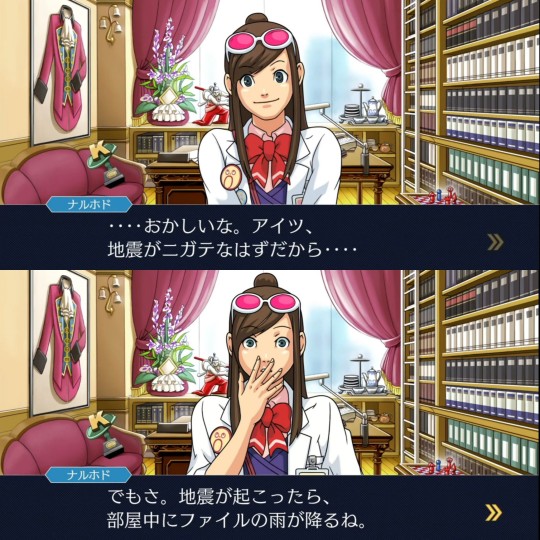
・・・・おかしいな。アイツ、 地震がニガテなはずだから……
Okashī na. Aitsu, jishin ga nigatena hazudakara……
...That's strange. He's supposed to be bad with earthquakes...
でもさ。地震が起こったら、 部屋中にファイルの雨が降るね。
demo sa. Jishin ga okottara, heya-chū ni fairu no amegafuru ne.
But if an earthquake happens, files will rain down all over the room.
In the localization (for some reason) at this point Mitsurugi was given a fear of heights. For what reason... I don't understand
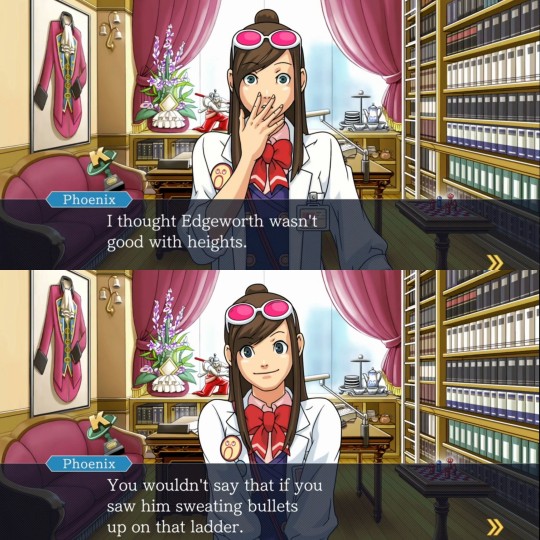
___________________________________________
Next, another big difference is Naruhodo's food preferences
In the Japanese version, Tomi the clown offers him miso ramen (which is cooked in chicken broth and miso), which Naruhodo refuses and says that he prefers tonkotsu ramen (cooked in pork broth and boiled pork is added to it).

ホラ。ホラ。 食う? みそラーメン。
hora. hora. Kuu? Miso rāmen.
Look. Look. Want some miso ramen?
あいにくぼくは とんこつ派なんです。
ainiku boku wa tonkotsu-hana ndesu.
Unfortunately, I prefer tonkotsu (ramen).
That is, Naruhodo literally says that he would prefer pork, not chicken.
What about the localization? It's the other way around.
The clown offers him a burger (the patties for which are usually made from beef and pork), but he says that he would rather choose a chicken sandwich.
Why?

___________________________________________
Vending machine in 1-3
I have no complaints about its contents (it is adapted), but here another preference of Naruhodo is lost

“お茶”“みそ汁”“おしるこ” “くず湯”“おでん”・・・・
“ocha” “misoshiru” “o shiruko” “kuzu yu” “oden”
"Tea" "Miso soup" "Oshiruko" "Kudzu soup" "Oden" ...
ラインナップが 和風に統一されている。
rain'nappu ga wafū ni tōitsu sa rete iru.
The lineup is unified in Japanese style.
“ウーロン茶”すらないぞ。
“ūron cha” sura nai zo.
There's not even "oolong tea."
In the Japanese version, reading the menu of the vending machine, Naruhodo annoyedly comments that "there is not even oolong tea". He literally names the tea he likes!
In the localization, he is disappointed that the food in the vending machine is too... ordinary, and he was expecting something that is not usually sold there (popcorn).

___________________________________________
Naruhodō University
Case 3-1 is very rich in information about the young Naruhodō, including the name of the university he attended
In the Japanese version, it is Yumei University (the same university where his ancestor Ryunosuke Naruhodō studied during the Meiji era - then it was called Yumei Imperial University), which creates an important reference to Dai Gyakuten Saiban (The Great Ace Attorney)
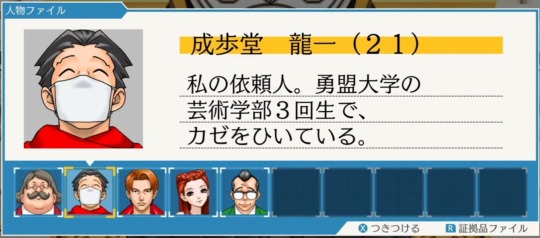
私の依頼人。勇盟大学の 芸術学部3回生で、 カゼをひいている。
watashi no iraijin. Yūmei daigaku no geijutsu gakubu 3-kaisei de, kaze o hīte iru.
My client. A third-year student in the art department at Yumei University, suffering from a cold.
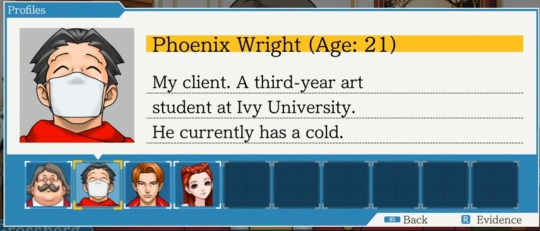
In the localization, he studies at Ivy University, as if referring to the famous Ivy League (elite universities).
A very good decision that shows Naruhodō's abilities and the high quality of his education (my clever boy)
___________________________________________
Interesting addition
And the last one for today, a conversation with Mask in the detention center
When Yusaku (Ron) tells the story of the allegedly lost vase, Naruhodō makes a comment about the absurdity of his story

(・・・・どう��、ハナシが アヤフヤだなあ・・・)(dōmo, hanashi ga ayafuya da nā)
(... I guess the story is a bit vague...)
The localization decided to make a reference to Naruhodō's education in the field of art, and he compares Mask's story to the surreal paintings of Dali.

A nice addition, but still different from the original version.
___________________________________________
In total, in my opinion, 3 unsuccessful changes out of 5.
If you also noticed any differences - feel free to tell us about them. Let's educate ourselves together.
It will be a bit more difficult with the subsequent parts, because I can't buy the Japanese version of TGAA (it is only available to a certain list of countries), and I don't have the new Apollo trilogy and the Investigations duology to check every little thing (and I don't have an extra $80), and those who record the walkthrough do not always check every clue, where the contradictions lie.
158 notes
·
View notes
Text
Learn Japanese with Easy Story!

ゆで卵の作り方を学ぼう! Yude tamago no tsukurikata o manabou! Let's learn how to make a boiled egg!
とても簡単だよ。 Totemo kantan da yo. It's very easy to do.
まず、卵��一つ選んでね。 Mazu, tamago o hitotsu erande ne. First, pick an egg.
卵が割れていないか確かめてね。 Tamago ga wareteinai ka tashikamete ne. Make sure the egg is not broken.
次に、卵をお湯の中に入れてね。 Tsugi ni, tamago o oyu no naka ni irete ne. Next, put the egg in a pot of boiling water.
約10分間、ゆでてね。 Yaku 10-punkan, yudete ne. Let it cook for about 10 minutes.
そのあと、卵を気をつけて取り出してね。 Sono ato, tamago o ki o tsukete toridashite ne. After that, take the egg out carefully.
殻をむいたら、ゆで卵ができあがり! Kara o muitara, yude tamago ga dekiagari! Peel off the shell, and your boiled egg is ready! Learn with CrunchyNihongo.com -> https://bit.ly/2Zk4l4K
まなぼう (manabou) – let's learn えらんで (erande) – choose (te-form of えらぶ) われていないか (wareteinai ka) – is not broken (negative form of われる / wareru) たしかめて (tashikamete) – check (te-form of たしかめる / tashikameru) いれて (irete) – put (te-form of いれる / ireru) ゆでて (yudete) – boil (te-form of ゆでる / yuderu) きおつけて (ki o tsukete) – carefully (te-form of きをつける / ki o tsukeru) とりだして (toridashite) – take out (te-form of とりだす / toridasu) むいたら (muitara) – after peeling (tara-form of むく / muku) Learn with CrunchyNihongo.com -> https://bit.ly/2Zk4l4K
ゆで たまご (yude tamago) – boiled egg つくりかた (tsukurikata) – how to make / method かんたん (kantan) – easy たまご (tamago) – egg ひとつ (hitotsu) – one (used for counting things) おゆ (oyu) – hot water なか (naka) – inside やく (yaku) – about (used when talking about time) ぷんかん (punkan) – minutes から (kara) – shell できあがり (dekiagari) – finished, ready (from できあがる / dekiagaru)
Learn with CrunchyNihongo.com -> https://bit.ly/2Zk4l4K
#nihongo#jlpt#japan#nippon#japanese#kanji#hiragana#katakana#hiragana reading practice#hiragana practice
56 notes
·
View notes
Text
Makochi Town Famous Shops Guide!!
Approved by Nii Satoru-sensei!

Saboten (Bakery) さぼてん
Popular items BEST3
1st Anpan
2nd Curry bread
3rd Yakisoba-pan
Regulars
Sakura - What he buys often: The curry bread is a recent favourite of his He was surprised when he ate one fresh out of the oven, and was hooked ever since.
Umemiya - What he buys often: Anpan It's been his favourite ever since he came to this town.




Tsukushi Butcher's Shop つくし精肉店
Popular items BEST3
1st Korokke
2nd Menchi-katsu [minced meat cutlet]
3rd Ebi-katsu [shrimp cutlet]
Regulars
Hiragi, Kaji - What he buys often: Korokke Because Hiragi-san treats me often (Kaji).




Kikuchi-ya (Japanese sweets shop) 菊地屋
Popular items BEST3
1st Dorayaki
2nd Mitarashi dango [see above picture]
3rd Warabimochi [1]
Regulars
Yanagida - What he buys often: Dorayaki He often goes to buy dorayaki to serve with tea at his parents' house.
Sakaki brothers - What they buy often: Warabimochi Warabimochi is just the best, right (Seiryu). I often go to accompany [2] Seiryu (Uryu).


1 Warabimochi (蕨餅) is a wagashi (Japanese confection) made from warabiko (bracken starch) and covered or dipped in kinako (sweet toasted soybean flour). Kuromitsu syrup is sometimes poured on top before serving as an added sweetener
2 「晴竜の付き添いでよく行くから」 - 付き添い can mean to accompany, attend, serve, wait on, attend to, assist

Café Pothos 喫茶店ポトス
Popular items BEST3
1st Omurice
2nd Handmade pudding
3rd Fully-packed egg sandwich
Regulars
Students of Furin - What they often order: Omurice The taste is excellent, and there's a discount for Furin students.



Muscle Power (Okonomiyaki [3] place) まっするぱわー
Popular items BEST3
1st Okonomiyaki that doesn't use flour
2nd Customized protein (banana & milk)
3rd Banana pound cake
Regulars
Tsugeura - What he often orders: Okonomiyaki that doesn't use flour It's nourishment for the muscles!

3 Okonomiyaki (お好み焼き) is a Japanese teppanyaki, savory pancake dish consisting of wheat flour batter and other ingredients (mixed, or as toppings) cooked on a teppan (flat griddle). Common additions include cabbage, meat, and seafood, and toppings include okonomiyaki sauce (made with Worcestershire sauce), aonori (dried seaweed flakes), katsuobushi (bonito flakes), Japanese mayonnaise, and pickled ginger.
[For the menu see the bonus at the end of chapter 32!]

Penpengusa (Monjayaki [4] place) ぺん��ん草
Popular items BEST3
1st Mentaiko mochi cheese monja
2nd Corn monja
3rd Seafood monja
Regulars
Anzai, Kurita, Kakiuchi, Takanashi - What they often order: Mentaiko mochi cheese monja It's delicious, and the restaurant is the perfect place for everyone to hang out! (Anzai)


[photos of before and after cooking for reference, not the ones mentioned in the rankings]
4 Monjayaki (もんじゃ焼き, often called simply "monja") is a type of Japanese pan-fried batter, popular in the Kantō region, similar to okonomiyaki, but using different liquid ingredients.
The ingredients in monjayaki are finely chopped and mixed into the batter before frying. Monjayaki batter has ingredients similar to okonomiyaki. However, additional dashi or water is added to the monjayaki batter mixture, making it runnier than okonomiyaki. The consistency of cooked monjayaki is comparable to melted cheese.
[BONUS TRIVIA]
Saboten - Cactus
Tsukushi - Horsetail
[Tsukushi (つくし) redirects to 杉菜 (スギナ sugina) on Wikipedia. Known as the field horsetail or common horsetail in English. The buds are eaten as a vegetable in Japan and Korea in spring.]
Kiku - Chrysanthemum
Pothos - ...Pothos
Penpengusa - Shepherd's purse
[Penpengusa (ぺんぺん草), or 薺 (なずな nazuna). Known as shepherd's purse in English. It is one of the ingredients of the symbolic dish consumed in the Japanese spring-time festival, Nanakusa-no-sekku.
The Festival of Seven Herbs or Nanakusa no sekku (Japanese: 七草の節句) is the long-standing Japanese custom of eating seven-herb rice porridge (七草粥, nanakusa-gayu, lit. "7 Herbs Rice-Congee") on January 7 (Jinjitsu); one of the Gosekku.]


[all extra information and photos from wikipedia]
[masterlist]
#wind breaker (satoru nii)#wind breaker character book#sakura haruka#umemiya hajime#hiragi toma#kaji ren#yanagida jien#sakaki twins#tachibana kotoha#tsugeura taiga#anzai masaki#wei translates#from the alleywei#i Must link a dozen wikipedia articles#fun section for writers/artists this time!#this took several hours (again)#thats bofurin done#shishitoren next! rest for one day (chp147 drops tomorrow!!)
125 notes
·
View notes
Text
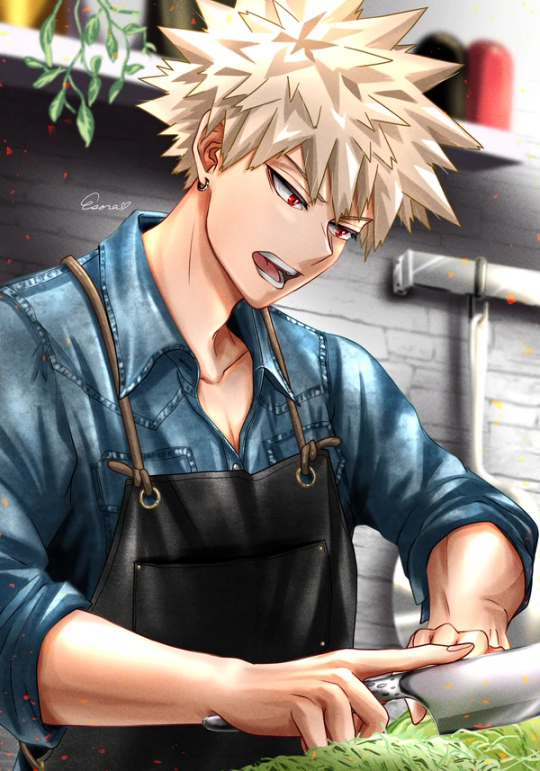
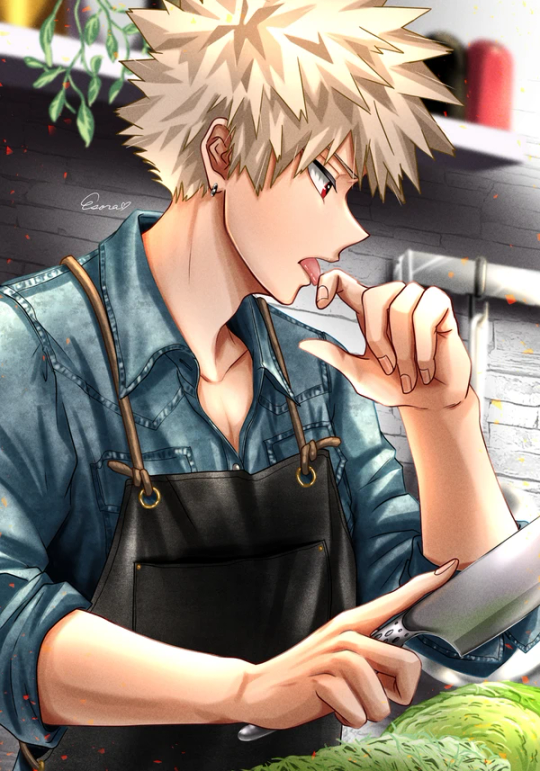
Esora
#fanart#baku no hero academia#baku no hero#my hero academia#bnha#mha#bakugo bnha#bakugou bnha#bnha fanart#bakugou#bakugo#bakugo katsuki#bakugou Katsuki#katsuki bakugo#katsuki bakugou#katsuki#bakugou katsuki#mha bakugou
363 notes
·
View notes
Text


Sean bienvenidos a la última publicación del año hoy dia 31/12/2021 se come Toshikoshi soba, para despedir el año ¿Cuándo surgió ?y ¿por qué?. _ Ya durante el siglo V ya era bastante popular , se ha comido de formas distintas proviene del trigo sarraceno, se comía tal cual o se mezclaba con agua y luego se cocinaba lo más probable es que fuera introducido por china a través de Corea . - ¿Cómo se llamaba al plato popular del siglo V? soba-gaki y para beber soba-yu( este era más popular en el periodo edo para las enfermedades). El trigo sarraceno se hacía como unas albóndigas que después se comen hervidas, ¿Posible comida para ricos?. La soba como la conocemos data del periodo Edo hasta nuestros días siglo 16 año 1574 aproximadamente. - ¿Combinación con la temperatura? Se hizo popular por la misma época mencionada anteriormente, la soba tiene vitamina B1. - ¿Cocían este plato o su historia? espero que se lo pasen bien en la noche de nochevieja un cordial saludo. -
今日の最後の出版物へようこそ2021年12月31日大晦しそばが食べられて、今年に別れを告げます。それはいつ起こったのですか?そしてなぜですか? すでにV世紀の間にそれはすでに非常に人気があり、それはさまざまな方法で食べられました、それはそばから来ます、それはそのまま食べられるか、水と混合されてから調理されました、それは韓国を通して中国によって導入された可能性が高いです。 5世紀の人気料理は何と呼ばれていましたか? そばがきとそば湯を飲む(江戸時代は病気で人気がありました)。 そばはミートボールのように作られ、後で茹でて食べられます。 ご存知のそばは江戸時代から現在の16世紀、1574年頃までさかのぼります。 温度との組み合わせ? 上記と同時期に人気を博し、そばにはビタミンB1が含まれています。 彼らはこの料理またはその歴史を調理しましたか? 大晦日、心からのご挨拶をお楽しみください。 -
Welcome to the last publication of the year today 12/31/2021 Toshikoshi soba is eaten, to say goodbye to the year. When did it arise? And why ?. Already during the V century it was already quite popular, it has been eaten in different ways, it comes from buckwheat, it was eaten as it is or mixed with water and then cooked, it is most likely that it was introduced by China through Korea. What was the popular dish of the 5th century called? soba-gaki and to drink soba-yu (this was more popular in the Edo period for illnesses). Buckwheat was made like meatballs that are later eaten boiled. Possible food for the rich? Soba as we know it dates from the Edo period to the present day 16th century, approximately 1574. Combination with temperature? It became popular around the same time mentioned above, soba has vitamin B1. Did they cook this dish or its history? I hope you have a good time on New Years Eve, a cordial greeting.
41 notes
·
View notes
Text
How To Use ところ
1. 駅に着いたところで、電車が出発しました。
"Just as I arrived at the station, the train departed."
2. 宿題をしているところです。
"I'm in the middle of doing my homework."
3. お腹がすいたところに、友達から食べ物の差し入れがありました。
"Just when I was hungry, my friend brought me some food."
4. 映画を見終わったところで、雨が降り始めました。
"Just after finishing the movie, it started to rain."
5. 電話をかけようとしたところで、バッテリーが切れてしまいました。
"Just as I was about to make a phone call, my battery died."
1. Indicating a Point in Time or Action:
"ところ" can indicate a specific point in time or action. It's often used with verbs in the present tense, present progressive form (-ている) to express an ongoing action; or past tense to indicate you have just finished doing something.
1a. Verb stem + ところ indicates you are about to do the action, you are going to start the action.
• 今から勉強するところです。"I'm about to study now "
1b. Verb present progressive form + ところ indicates you are in the midst of doing the action. You are currently doing the action.
• 彼は料理を作っているところです。 "He is in the middle of cooking."
1c. Verb past tense + ところ indicates you have finished the action; the action is completed.
• ちょうど帰って来たところです。"I just got home."
• 彼女はお風呂から出たところです。 "She has just come out of the bath."
2. Indicating Circumstances or Situations:
"ところ" can also describe the circumstances or situation surrounding an action or event.
• 電車に乗るところで、友達に会いました。 "I met my friend while I was about to board the train."
3. Indicating a Close Call or Coincidence: Verb stem + ところ (だった / でした) can express a situation where something narrowly almost happened or coincidentally occurred.
• 遅れるところでしたが、間に合いました。 "I almost arrived late, but I made it in time."
4. Expressing Inevitability:
In some cases, "ところ" can convey a sense of inevitability or expectation regarding an action or event.
• 彼はいつか成功するところだ。 "He is bound to succeed someday."
5. Indicating a Specific Place or Location: While less common, "ところ" can also mean "place" or "location" when used in specific contexts.
• ここは賑やかなところです。 "This place is lively."
6. Expressing Emotional States:
In colloquial language, "ところ" can sometimes be used to express one's emotional state or feelings.
• びっ��りしたところです。 "I was surprised."
#japanese#jlpt#jlpt n1#jlpt n2#jlpt n3#jlpt n4#jlpt n5#language#learn japanese#nihongo#japanese grammar#grammar#文法#にほんご#日本語
137 notes
·
View notes
Text
食材の多い料理店
The Restaurant of Many Ingredients (Much Meat)
全身白髪だらけだと
As he strokes his red crest,
赤いとさかを撫でながら
Fry Kitchen grumbles that he's covered
フライ・キッチンがぼやく
Head to toe in white hairs
石臼での粉挽きなど
This is the first time in his life
生まれて初めて 昔は
That he's ever ground flour with a stone mortar
そんな身分じゃなかった
This hadn't been his standing in life in the past
.
屍用人に身を落としても
Though he'd stooped to the position of undead servant
家畜の姿に変わっても
Though his form had changed to that of livestock
意外と気分は悪くない
It actually isn't all that bad
今になって気がついたのさ
It was now that he realized
机に積まれた札束など
That stacks of money piled up on a desk
何の意味も無かったんだと
Don't really mean anything
.
肉の焦げた匂いが漂う
The smell of charred meat wafts through the air
次は自分じゃない事を祈る
He prays that he isn't next
.
ずっとうんざりしてたのさ
He'd always been so bored and fed up
23人の兄弟ども
So he finally bid farewell
ようやく別れを告げて
To his 23 siblings
ポーク・チョップは独立した
Pork Chop had set out on his own
嬉しい事のはずなのに
This should have been a happy thing
何故だか少し寂しい
But somehow it was a little lonesome
.
鼻を鳴らして野菜を切る
He cuts vegetables while snuffling and snorting
刃物の扱いは慣れたものさ
He's gotten used to holding a knife
何人も刻んできたから
Since he's chopped up countless people
希代の始末屋だったのに
He'd once been uncommonly stingy
今じゃのろまの従兄弟にさえも
But nowadays he can't even hold a candle
頭があがりゃしないのさ
To those blockhead cousins of his
.
熊の瞳がこっちを見ている
The bear's eyes are looking his way
獲物が自分じゃない事を祈る
He prays that he's not its prey
.
憧れのあの方にならば
Chateau Briand had declared that
食べられても構いませんわ
As long as it was by the one he admired
シャトー・ブリアンは言い切った
He wouldn't mind being eaten
あの日話しかけられなくて
He hadn't been able to speak to them that day
助ける事が出来なかった
And so couldn't save them
後悔は今も残る
His regrets linger even now
.
16人目のコックになる
He'd become the 16th cook
決意して門をたたいたけど
Though he had mustered his will and applied for an apprenticeship
既に屋敷は��ぬけの殻
The mansion was already an empty husk
今ではもうあの時とは
And now everything
全てが変わってしまったけど
Is different from the way things were then
変わらないものだってあるの
Yet there are some things that haven't changed
.
けだるげな赤猫をみかける
He spies a listless looking red cat
自分のお腹の肉をなでる
It pats the meat of his belly
.
たどたどしい手つきの料理
I wordlessly gaze upon
行う弟子たちの姿を
The sight of my pupils
俺は無言で眺める
Carrying out their clumsy cooking technique
昔のことなど忘れた
I've forgotten most of my past
それでもこの調理場には
Even so, this kitchen
懐かしい匂いがする
Has a scent that brings back memories
.
誰かと旅をし料理をする
To go traveling with someone, and make food with them,
それがかつて自分が望んだ
Wasn't that the life that I had once
生活だったのだろうか
Wished to have?
店をにぎわす異界の客
These guests from the parallel world bustling through the restaurant,
彼らのために用意された
I reach for the new ingredient
新たな食材を手に取る
That I've prepared for them
.
幸せの花は赤く綺麗で
The flower of happiness is a lovely red
メインディッシュのスパイスに最適
It'll be a perfect spice for the main dish
.
再び弟子たちに目をやる
Again he looks towards his apprentices
選ばなければならない
He'll have to select
メインディッシュの食材を
The main ingredient for the main dish
不足で困る事は無い
He isn't lacking in choice
ここはとても食材の多い
This is Mister Dog's restaurant
ミスター・ドッグの料理店
Of many ingredients
29 notes
·
View notes
Photo

✿ マジで止まらなくなる悪魔のおにぎり
#cook:マジで止まらなくなる悪魔のおにぎり#cook:おにぎり#cook:主食#cook:たくあん#cook:明太子#cook:ツナ缶#cook:米#cook:天かす#cook:めんつゆ#cook:マヨネーズ×めんつゆ#cook:マヨネーズ×明太子×めんつゆ#cook#2020〜#cook:2020〜#cook:大葉#cook:おおば#cook:のり#cook:海苔
7 notes
·
View notes
Photo
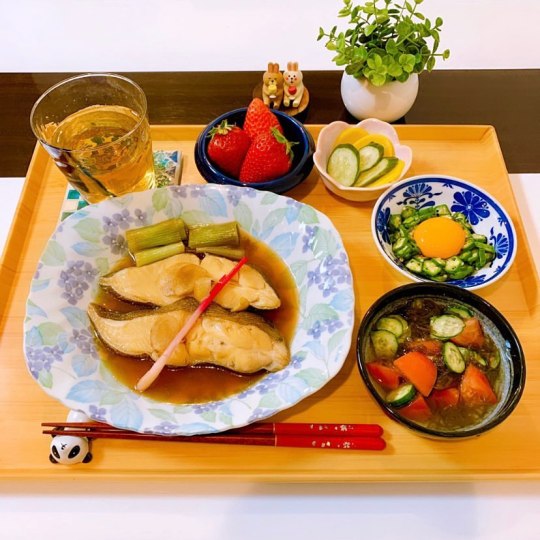
なう(2023/03/10 19:30:47) 今夜はカラスガレイの煮付け🐟 肝の煮付け食べたいなぁ🥺週末 魚のアメ横行こうかな??? #カラスガレイの煮付け #もずく酢 #月見おくら #奈良県産苺ならあかり #家飲み #おうち居酒屋 #おうちごはん #お家ごはん #おうちごはん部 #おうちごはんlover #今日の晩ごはん #TodaysDinner #晩ごはん #晩ごはん記録 #献立記録 #自炊記録 #てづくりごはん #手作りごはん #てづくりごはん365 #cooking #cook365 #タベリー #フーディーテーブル #クッキングラム #キッチングラム #いいね返し #夫婦ごはん #ふたりごはん #豊かな食卓 #家庭料理 最近映画も飽きてきたしGWの予定でも 立てよーと思て新潟⇔ベトナム直行便の 予約をしようと思たら何と😳⁉️ 新潟からはホーチミンでもハノイでもなく ダナン行きの✈️しかないやとー😱?💦 ダナンみたいなビーチリゾート行くんやったら ベトナムじゃなくてもえーわ😭 ベトナムさを感じたいのに何でダナンなん😫 成田空港まで7時間かけて車かバスで行くか 関空でトランジットして割増で行けば ホーチミン行けるけど無駄にしか思えん😭 せっかく新潟空港歩いて行ける範囲に住んでるのに 成田やら大阪まで行ってから…なんて事は 絶対したくない😂😂😂 昨日ベトナムるるぶも買ったのに最悪や 新潟空港使えねー🤪仕切り直しやな😢 https://www.instagram.com/p/CpmwJJCyai3/?igshid=NGJjMDIxMWI=
#カラスガレイの煮付け#もずく酢#月見おくら#奈良県産苺ならあかり#家飲み#おうち居酒屋#おうちごはん#お家ごはん#おうちごはん部#おうちごはんlover#今日の晩ごはん#todaysdinner#晩ごはん#晩ごはん記録#献立記録#自炊記録#てづくりごはん#手作りごはん#てづくりごはん365#cooking#cook365#タベリー#フーディーテーブル#クッキングラム#キッチングラム#いいね返し#夫婦ごはん#ふたりごはん#豊かな食卓#家庭料理
2 notes
·
View notes
Text

ヤツは家主にとってもキョウイのクロネコなのよ
ヤツの家主へのアクギョウを
あらためて皆さんにおしえるのよ
He is the menace also for my landlady...so I'm going to tell you about his wrongdoing again.
れいぞこの こおりすとっかーをあけて できたこおりを ぜんぶとかした
↑ゆか水びたし
家主がこおりを作らなくなったら こおりすとっかーに入っていた
↑フタつきカゴをかうことになった
たおるカゴに入り くろい毛だらけにした(シャシンさんしょう)
タナにのぼってフキンカゴをおとす
↑ぜんぶせんたくすることになった
↑フタつきカゴをかうことになった
ゴハンじゃぁ たいまーじかんまえにフタをあけて ゴハンをダイナシにした
ゴハンじゃぁ かってにあけてくう
↑ヨコぼたんのじゃぁをかうことになった
おべんとバコのゴハンをくう
おもちつきのおコメをかってにくう
パスタのふくろを あけてかじる
らぁめんのふくろを あけてかじる
ぷりんくってる家主をおそう
He opened the ice stocker of her refrigerator and let all ice cubes melted
↑it inundated the floor
He entered that stock space after she quit to make ices
He entered her towel box(example photo) and put black furs all the towels
↑ she needed to buy a new box with a lid
He threw away her kitchen cloth box when he climbed and entered the shelf
↑she needed to wash them again
↑ she needed to buy a new box with a lid
He opened the rice cooker before it started to cook so she couldn't have rice at the morning
He opened the rice cooker and ate rice
She needed to buy a new cooker with the side button
He ate rice in her lunch box
He ate mochi rice before she cook
He opened the package of pasta and ate them
He opened the package of lamen and ate them
He raids her every time while she's eating her favorite pudding
6K notes
·
View notes
Text
“Shut Up and Eat” yakiniku omake — original Japanese dialogue analysis and translation
The 3rd installment of the four-part yakiniku omake series in Mob Psycho 100 involves a bit of clever wordplay to make Mob’s slurring make sense, which means that the translation had to play around with the words a little bit to make it work in English. So, what did Mob actually say in Japanese?
I got the raws from the Manga One app in the Japanese iTunes app store.
I would like to preface this by saying that the most popular translated version, where Mob says the infamous “Shut up and eat” line, is the best translated version in my opinion, because Mob actually slurring that is a totally feasible thing. I’ll explain more about that in the translation notes below, but this version I translated isn’t reworked to match the syllables and make the slurring believable, but rather to try and represent the Japanese meaning.
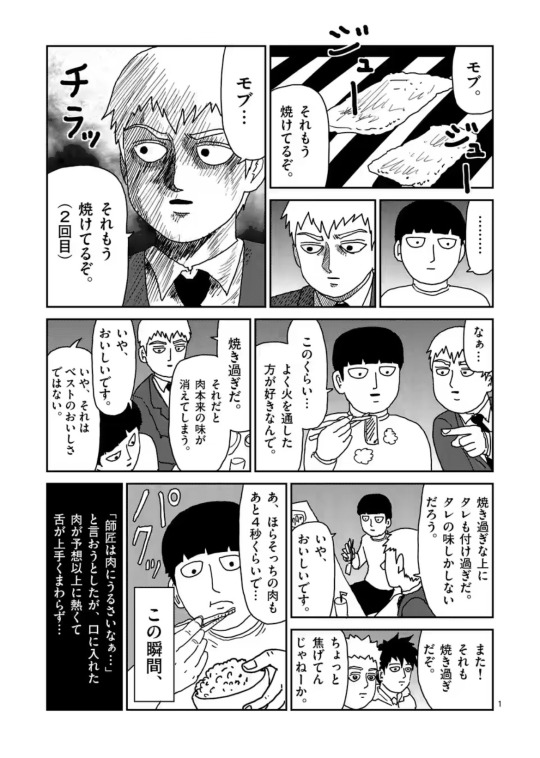
Reigen: モブ。— Mob.
それもう焼けてるぞ。— It’s about to burn!
Mob: ………
Reigen: モブ… —Mob…
それもう焼けてるぞ。(二回目) — It’s about to burn. (A second time)
なぁ… — Hey…
Mob: このくらい…よく火を通した方が好きなんで。— It’s good like this. I like the heat to spread evenly throughout.
Reigen: 焼き過ぎだ。それだと肉本来の味が消えてしまう。—It’s cooking too much. It’s going to completely lose the original flavor.
Mob: いや、おいしいです。— No, it’s tasty.
Reigen: いや、それはベストのおいしさではない。— No, that’s not the best taste.
焼き過ぎな上にタレも付け過ぎだ。タレの味しかしないだろう。— It’s overcooked and you put too much sauce on top.
Mob: いや、おいしいです。— No, it’s tasty.
Reigen: また!それも焼き過ぎだぞ。— Again! That one’s also cooking too much.
ちょっと焦げてんじゃねーか。— It’s a bit scorched, isn’t it?
あ、ほらそっちの肉もあと4秒くらいで… — Ah, look—that piece of meat, in about four seconds…
「師匠は肉にうるさいなぁ…」と言おうとしたが、口に入れた肉が予想以上に熱くて舌が上手くまわらず… — “Shishou is picky about meat, huh…” is what Mob tried to say, but when he put the meat in his mouth, it was hotter than expected and his tongue couldn’t articulate well.
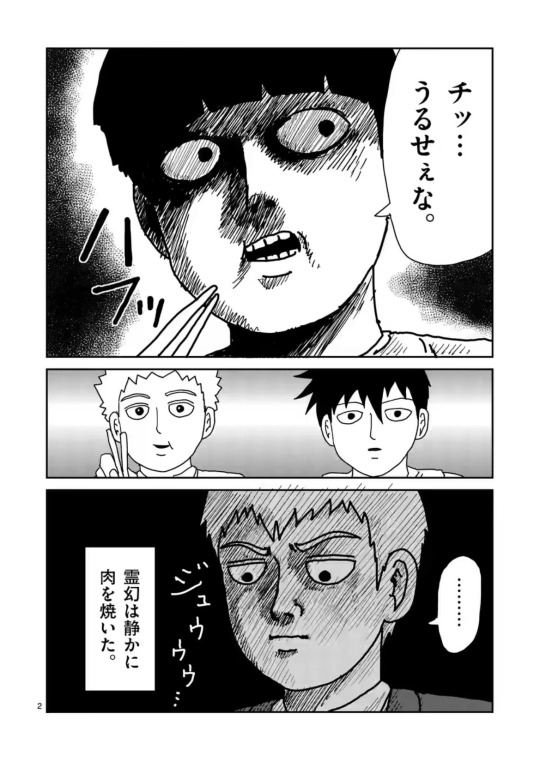
Mob: チッ… うるせぇな。— Tch… Shut the hell up.
Reigen: ………..
霊幻は静かに肉を焼いた。— Reigen cooked his meat in silence.
——————————
Notes:
- Mob: このくらい…よく火を通した方が好きなんで。— It’s good like this. I like the heat to spread evenly throughout.
「このくらい…」 actually directly translates to “This much…” (in regards to how much he’s cooking the meat over the grill). It employs the Japanese technique of “only say half the sentence and let the rest be unspoken”, but that wouldn’t make a lot of sense in English and kind of sticks out translated strictly like that. So I just finished the sentence.
- Mob: チッ… うるせぇな。— Tch… Shut the hell up.
So, this whole thing is a joke about the many uses of the word 「うるさい」 (urusai). 「うるさい 」 can be used to mean “loud/noisy”, “annoying/bothersome”, “picky/fussy/particular”, and “shut up!” when shouted as an interjection. I’ve been in a class in Tokyo where we were all yelled at for talking by our professor, who kept saying 「うるさいだよ!」. In Mob’s originally-intended sentence—「師匠は肉にうるさいなぁ…」—he was using うるさい to mean “picky/fussy”, since Reigen truly would not relax and leave him alone over that meat. But because the meat burned his mouth, he ended up clicking his tongue and slurring 「うるせぇな。」 He dropped the “Shishou” and “about meat” parts entirely, his hurt tongue not moving fast enough and holding out an “e” vowel throughout the latter half of the word instead of raising up into an “ai” sound. This… makes the word very rude. And since all other parts of the sentence were dropped, it also makes it an interjection— a rude and harsh version of “Shut up!”, which I’ve chosen to represent by making Mob curse. (Turning rude conjugation forms into English cursing is a pretty common practice in Japanese translation, as they have more expressive conjugation forms than us and we have no other real way to express that inherent hostility/brashness.)
In the most popularized English translation of this scene, the translators did something very clever to make Mob’s slurring possible, since we don’t have “rude” verb forms in English. What Mob originally wanted to say was, “Shishou sure likes to talk about meat…”, which gets slurred into “Shut up and eat.” The syllables specifically from “shishou” and “about meat” can be slurred into something phonetically resembling “shut up and eat”. I think this is extremely clever and fantastic translation work.
Anyway. Reigen deserved that.
#mp100#mp100 manga analysis#mp100 analysis#mp100 manga#mob psycho 100#shigeo kageyama#mp100 omake#mp100 translation#japanese translation#fan translation#reigen arakata
540 notes
·
View notes
Text
SplatoonNA:
SRL here, we've cooked up the theme for the next Splatfest... or you could say Starch Fest 👀 This time it asks "Which would you eat every day? Bread, Rice, or Pasta?"
This Splatfest kicks off on 8/9 at 5PM PT until 8/11 at 5PM PT. Hope you're ready to work up an appetite!
SplatoonJP:
第18回フェスの開催が決定したぞ!
お題は「おなかいっぱい食べるなら? パン vs ごはん vs パスタ」。
期間は、8月10日(土)午前9時~8月12日(月)午前9時の48時間だ。
どう食べるかはお好みで。ただし、食べすぎには要注意だ。
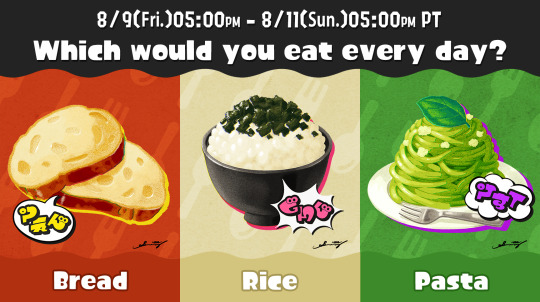
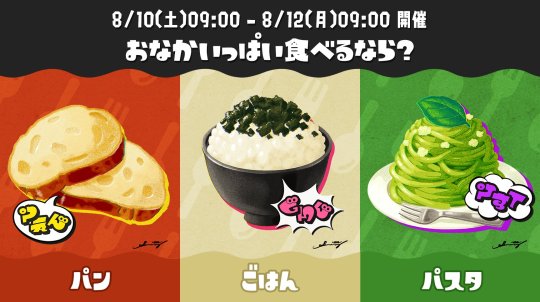
38 notes
·
View notes